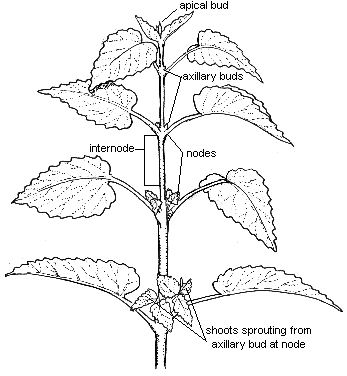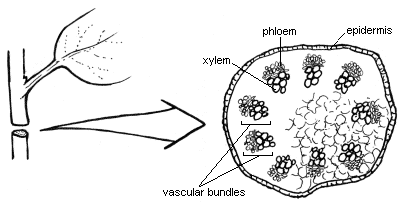 |
|
Copyright 1999, National Gardening Association.
All Rights Reserved.
For questions regarding this web site, contact Webmaster |
Stems |
|
|
"...that
thing that comes up from the ground that the leaves attach to"
Stems
are the above-ground structures that bear the plant’s leaves
and flowers. The stem provides a host of services to the plant:
- It
provides a pathway for transporting water up to the leaves,
and moving the sugars produced in the leaves down to nourish
the roots.
- It
acts as a sturdy mast to hold up the leaves and help orient
them for maximum exposure to sunlight.
- It
can act as a storage site for carbohydrates.
All stems have nodes
along their length. A node is the point at which a leaf attaches
to a stem. Small buds called axillary
buds occur at nodes, typically just above where the leaf
meets the stem (the leaf axil). These buds may sprout to form
new leaves or side shoots. The very tip of the stem where the
most rapid growth usually occurs is called the apical
bud (apex=highest point).


Many familiar garden plants’
stems are soft and green; these are called herbaceous
(her-BAY-shus) stems. Examples include the stems of annuals
like impatiens and lettuce, and perennials such as hostas and
lupines. The stems of trees and shrubs also start out soft and
green, but become woody as they mature.
Stems contain vascular tissues—the
"circulatory system" of the plant. Similar to our
blood vessels, vascular tissues form an intricate network of
veins that carry fluids throughout the plant. Large cells of
the xylem (ZY-lem; Gr. xylon=wood)
form a conduit for transporting water up from the roots; the
smaller cells of the phloem
(FLOW-em; Gr. phloos=bark) transport sugars produced
in the leaves.
In herbaceous stems, the xylem
and phloem are contained in vascular bundles.
Herbaceous stem cross-section

A plant’s shoot
system consists of its above-ground stems, plus any branches
and leaves.
|
|

Handle with Care
When transplanting
tender seedlings, you should always grasp them by their leaves, not their stems. If a leaf
is damaged, the plant can replace it; if the main stem is damaged, it can’t be
replaced. |
|

Buds and Sprouts
On some plants, such
as philodendron, the axillary buds are small and may not be easily visible. But if you
examine the vines, you’ll probably see places where a side branch has arisen from an
axillary bud at a node. And if you prune one of the vines back to a node, you’ll
likely find a side shoot forming within a few weeks.
The axillary buds on
tomato and coleus sprout freely, and you’ll often see shoots arising in the leaf
axils. If you’ve ever pruned "suckers" off your tomato plants, you’ve
removed shoots that have arisen from axillary buds. |
|
|